This case study tells the story of an industrial company through its innovation journey from a traditional, product-centered process to an innovative model capable of generating 2% of the company’s revenue. The model was built based on three pillars – the ideation process, screening standards and open ideation platform.
The company
A player in the food industry for several decades, the company in question combines tradition and rigor with a focus on innovation as a formula for success for its long-term growth.
Spread around the world, the company’s products are part of the daily lives of consumers. In addition to the best ingredients, texture, and flavor, each product reflects the experience, dedication and knowledge of many people, generations and teams, as well as their desire to innovate, to be at the forefront of technology and to support sustainable development.
However, the innovation process was product-centered and there was a need to broaden the scope.
The challenge
The Breakthrough Ideation project started after a two-year journey of continuous improvement within the production, logistics and maintenance areas.
In the diagnosis phase, the innovation process was analyzed and the multifunctional team realized that despite the effort to innovate, the innovation was informal and narrow (product-centered). Moreover, there was the absence of an idea generation process and a gap between successfully approved ideas and the New Product Development (NPD) funnel.
With this opportunity in mind, the purpose of the project was to establish a strong process and define the right governance for innovation as a core growth driver.
The approach
The first step was to clarify the essence and different approaches to Ideation and New Product Development. On one side, ideation targets medium/long-term disruptions in business models, services, products, equipment and technology. On the other side, the new product development materializes in short-term projects created by the internal team to deliver new products to the market.
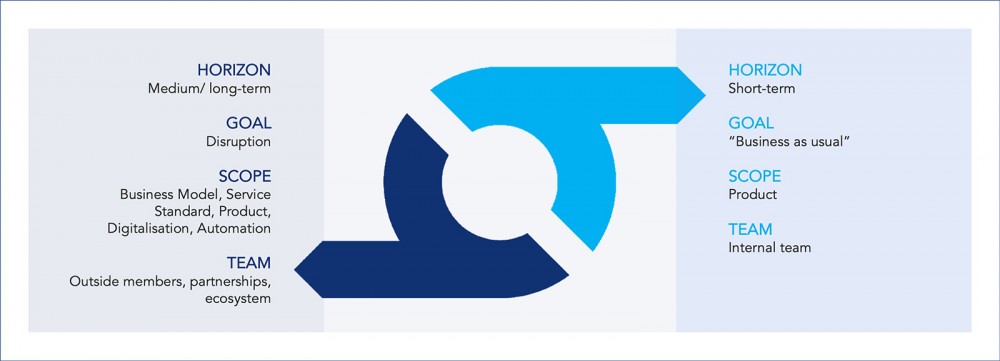
Ideation vs. NPD
The ideation model was built based on three improvement pillars:
- Development of a company-wide and strategy-linked ideation process
- Implementation of a screening process for idea prioritization and assessment
- Development of an open ideation platform with an external pool of contributors (suppliers, customers, clients and field experts)
Ideation System
Since the target was to establish the innovation process as a growth driver, it was decided that the ideation resources would directly report to the board. This team would act as project managers in the development of ideas with multifunctional teams with people from inside the company as well as tech and science actors, customers and suppliers.
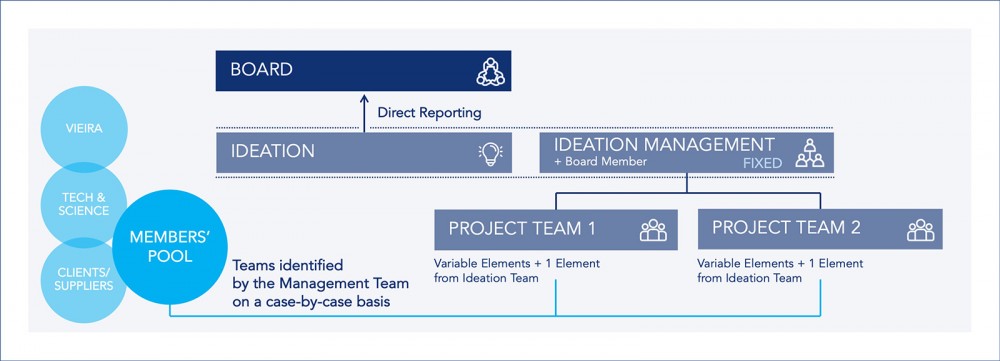
Governance model
The next step was to define the sequence of activities needed to reach a pool of rich and fruitful ideas that would start with the business strategy and insight integration as well as idea creation, filtering, prioritization and development. This was time bounded in the annual calendar of activities with five key moments:
- Strategy communication and deployment to innovation team
- Trends presentation
- Ideation forum
- Follow-up session of ideation projects
- Final presentation and project selection
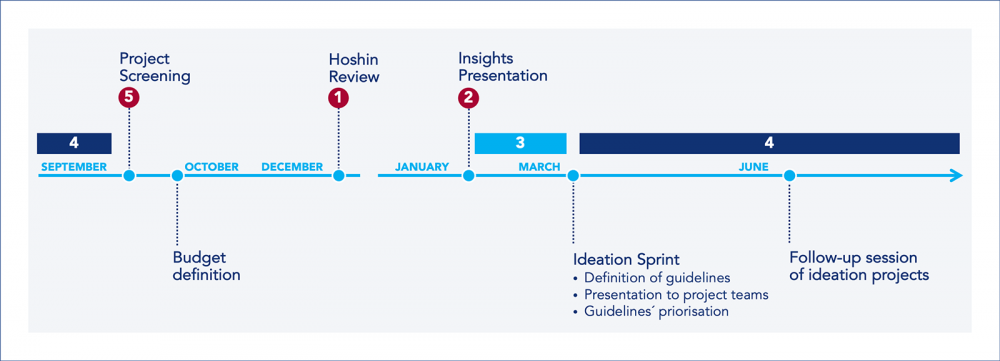
Annual ideation calendar
Open ideation platform
The open ideation platform is a place where the ‘community’ can present, vote and discuss their ideas. The platform works with upvoting where each person can like and complement others’ ideas leading the most liked ideas to get higher scores and therefore higher visibility.
In this case, two platforms were created – an internal platform to challenge internal stakeholders to ideate around specific topics and open platforms to collect the best ideas from players all over the world.

Open ideation contributors mapping
Apart from the open ideation outputs, the thought inputs come from multiple sources:
- Improvement cycles (PDCA) from teams in all tiers of the organization
- Consumer/market/customer service lines that are integrated by the marketing team as well as business intelligence analysis
- Suppliers
- Brainstorming sessions by the ideation team
- Complaints sorted by the quality department
Idea generation process
The idea generation process starts within the organization with analysis of thoughts captured from multiple sources and is followed by brainstorming sessions.
After mapping all the insights, they are combined in clusters marking the starting point for the idea creation stage which is based in clearly defined guidelines.
This process happens during the ideation forum sessions with standard agendas and protocols.
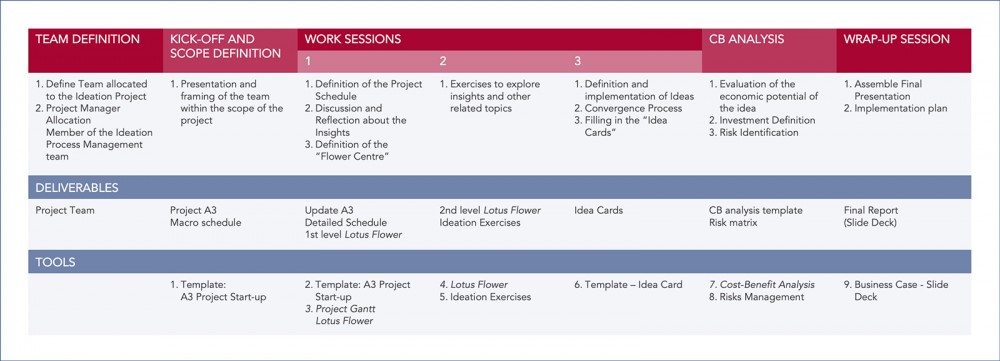
Ideation process with milestones, deliverables and tools
Idea screening process
At this stage, the team should detail the ideas that have emerged using the ‘Idea Card’. The card allows a simple and visual way to understand the different ideas summarized with the main points – a brief description of the idea, implementation requirements and estimates of benefits, investment and time-to-market.
The systematized description facilitates the comparison of ideas for the selection of those that should continue in the process.

Idea card
For the selected ideas, it is necessary to carry out an evaluation of their potential considering:
- Necessary investment – quantify the cost-benefit analysis of the different items
- Estimated benefits – define in more detail than in the ‘Idea Card’ what the gains with the implementation can be
- Risk management – use the tool to classify and quantify the associated risks and the impact they may have
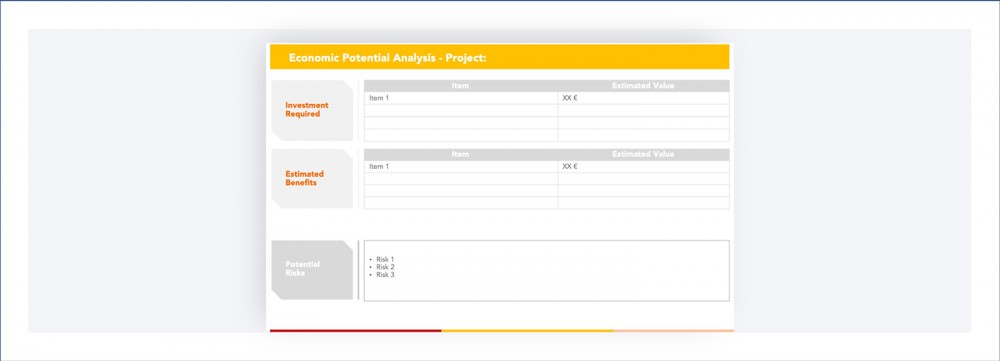
Economic potential analysis of executing the idea
The last step would be the handover to the project implementation team and the joint creation of the project initiation A3.
Achievements
In the first year of implementation, eight ideas were selected and developed, and two innovative concepts were moved to the project development funnel. The revenue generated by the innovation process accounted for 2.2% of annual revenue and was the first step towards the inorganic growth of the company.
#processmanufacturing #innovation and expansion
See more on Process Manufacturing
Find out more about transformation in this sector
See more on Innovation & Expansion
Find out more about improving this business area
